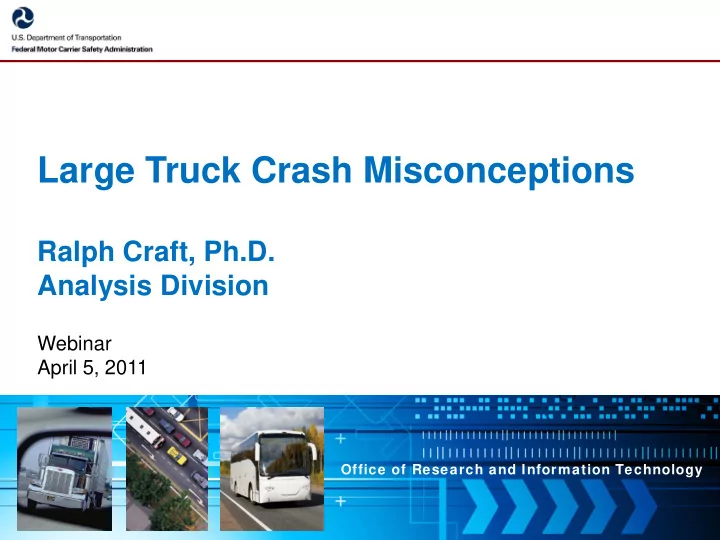

Large Truck Crash Misconceptions Ralph Craft, Ph.D. Analysis Division Webinar April 5, 2011 Office of Research and Information Technology
Data Sources Large Truck Crash Causation Study (LTCCS), 2001- 2003, FMCSA National Motor Vehicle Crash Causation Study (NMVCCS), National Highway Traffic Safety Administration (NHTSA), 2005-2007 Individual State studies Fatality Analysis Reporting System (FARS), NHTSA, 1994-2009 General Estimates System (GES), NHTSA, 2008 Vehicle Miles Traveled, Federal Highway Administration, 2008 1 Office of Research and Information Technology
Misconceptions 1. Cars cause 70 percent of all truck crashes 2. Alcohol and illegal drugs are major truck crash causes 3. Truck drivers are in poor condition to drive 4. Driver inattention/distraction is a new problem resulting from new electronic devices 5. Truck vehicle problems are top crash causes 6. Americans are bad drivers 7. Good laws and effective enforcement can eliminate almost all truck crashes 2 Office of Research and Information Technology
1 - Cars cause 70% of All Truck Crashes Misconception Origin: In 71% of two-vehicle large truck- passenger vehicle fatal crashes, the passenger vehicle driver was coded with one or more crash factors and the truck driver was coded with none – FARS, 1994 and 1996 Problems with origin: Only fatal crashes – 1% of large truck crashes No single vehicle crashes which are 20% of fatal crashes Based on Police Accident Reports, not in-depth investigations Only driver factors considered Some factors were not pre-crash – hit-and-run, non-traffic violations, noncompliance with license restrictions 3 Office of Research and Information Technology
1.a - Cars cause 70% of Truck Crashes LTCCS – Trucks coded with Critical Reason (CR) in 55% of the 963 crashes: 28% of fatals; 57% of injury crashes NMVCCS – Trucks coded with CR in 39% of crashes California, 2004-08 – Truck drivers were at fault in 25% of 1,628 fatal crashes and 48% of 35,818 injury crashes Florida, 1998-00 – Trucks at fault in 31% of fatal crashes Michigan, 2001-05 – In 86,638 two-vehicle crashes, CMVs took hazardous actions in 42%; non-CMVs in 41% North Carolina, 1994-97 – Trucks were at fault in 48% of the 16,264 truck-car crashes Oregon, 2005 – Trucks at fault in 55% of the 1,252 crashes 4 Office of Research and Information Technology
2 - Alcohol & Illegal Drugs are Major Crash Causes LTCCS, 2001-2003, truck drivers: 1% had consumed some alcohol 2% used illegal drugs 18% used over-the-counter drugs 26% took prescription drugs FARS, 2008 and 2009, truck drivers: 2% blood alcohol content greater than 0.01 1% blood alcohol content of 0.08 or greater 1% coded under influence of alcohol or drugs 5 Office of Research and Information Technology
3 - Truck Drivers are in Poor Condition to Drive Mixed Data Fatigue Truck drivers in LTCCS – 13% Passenger vehicle drivers in NMVCCS – 8% Driver unable to perform the task of driving (as a result of heart attack, stroke, diabetic shock, being asleep, and other conditions) - coded as a Critical Reason in both the LTCCS and NMVCCS Truck drivers in the LTCCS – 12% Passenger vehicle drivers in NMVCCS – 9% 6 Office of Research and Information Technology
3.a - Truck Drivers are in Poor Condition to Drive Inattentive/Distracted Truck drivers – 20% in LTCCS Passenger vehicle drivers – 29% in NMVCCS Illegal Drugs Truck drivers – 2% in LTCCS Passenger vehicle drivers – 5% in NMVCCS Alcohol Truck drivers – 1% in LTCCS; 2% in FARS 2009 Passenger vehicle drivers – 5% in NMVCCS; 27% in FARS 2009 7 Office of Research and Information Technology
4 - Inattention/Distraction: the New Threat New electronic devices (laptop computers, cell phones, GPS systems) promote truck driver distraction/inattention that was not a problem in the past Driver inattention was coded as the fourth highest FARS driver crash factor in 1994-97 NHTSA establishes distraction task force in 2000 Inattention now coded in FARS 2009 as third highest driver crash factors for large trucks and fourth highest driver factor for passenger vehicles Most inattention/distraction has little to do with new electronic devices – daydreaming, talking, reading, looking at a person or object outside vehicle 8 Office of Research and Information Technology
5 - Truck Vehicle Problems are Top Crash Causes Data LTCCS – When the truck was coded with the Critical Event, vehicle problems were coded as the Critical Reason in only 8% of the crashes, while driver factors were coded as the critical reason in 88% of the crashes FARS 2009 – driver factors were coded in 31% of the large truck crashes, while vehicle crash-related factors were coded in only 5% of the large truck crashes Brakes coded in 1.4% of crashes Tires coded in 1.2% of crashes 9 Office of Research and Information Technology
6 - Americans are Bad Drivers Data – FARS and FHWA, 2008 1.79 large trucks are involved in fatal crashes, and 29.1 are involved in injury crashes per 100 million miles traveled by large trucks 1.45 passenger vehicles are involved in fatal crashes and 99.8 are involved injury crashes per 100 million miles traveled by passenger vehicles The Truth – In the United States we have safe roadways safe vehicles safe drivers 10 Office of Research and Information Technology
7 - Only Good Laws and Enforcement Needed Extremely important, but can’t do it all Consider speeding, alcohol use Speeding – top driver crash factor for large trucks and passenger vehicles, FARS 2009 Alcohol – 10,839 people killed in crashes where a driver was legally drunk, FARS 2009 Personal responsibility is critical - drivers always have to First - be in good shape to drive Second - pay attention to the driving task 11 Office of Research and Information Technology
Ralph Craft ( 202) 366-0324 Ralph.Craft@dot.gov 12 Office of Research and Information Technology
Recommend
More recommend